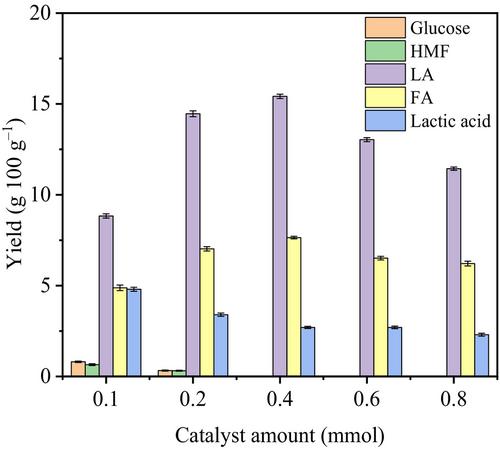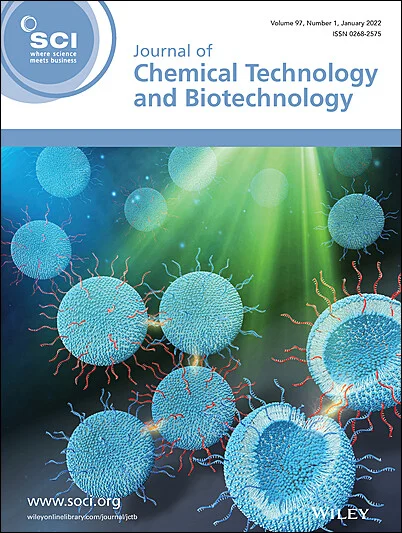Hui Wang, Zhihao Chen, Zhongcheng Guo, Yangyang Ma, Xiaomei Yang, Lipeng Zhou, Chen Chen, Fayi Wang
求助PDF
{"title":"通过汽爆和氧化-水解路线从烟草梗中合成乙酰丙酸","authors":"Hui Wang, Zhihao Chen, Zhongcheng Guo, Yangyang Ma, Xiaomei Yang, Lipeng Zhou, Chen Chen, Fayi Wang","doi":"10.1002/jctb.7746","DOIUrl":null,"url":null,"abstract":"<div>\n \n \n <section>\n \n <h3> BACKGROUND</h3>\n \n <p>Tobacco stalk, the main waste from tobacco planting, was used as raw material to produce levulinic acid, one of the most important platform chemicals. It was reported that steam explosion was an efficient method to treat lignocellulose to hydrolyze the hemicellulose component. Oxidation treatment combined with catalysis of Al<sub>2</sub>(SO<sub>4</sub>)<sub>3</sub> proved to be efficient for the conversion of cellulose to levulinic acid in our recent report. Here, tobacco stalk was first treated by steam explosion, and then the solid residue was oxidized and converted to levulinic acid in the presence of Al<sub>2</sub>(SO<sub>4</sub>)<sub>3</sub>.</p>\n </section>\n \n <section>\n \n <h3> RESULTS</h3>\n \n <p>A xylo-oligosaccharide yield of 6.6 g 100 g<sup>−1</sup> was obtained from tobacco stalk via steam explosion. 15.4 g 100 g<sup>−1</sup> (39.6 mol%) yield of levulinic acid was obtained from oxidized tobacco stalk in water at 180 °C in 5 h using Al<sub>2</sub>(SO<sub>4</sub>)<sub>3</sub> as a catalyst. As high as 20.8 g 100 g<sup>−1</sup> (53.5 mol%) yield of levulinic acid can be obtained using NaCl as a co-catalyst.</p>\n </section>\n \n <section>\n \n <h3> CONCLUSION</h3>\n \n <p>Steam explosion was efficient for the depolymerization of the hemicellulose component of tobacco stalk to xylo-oligosaccharide. A simple salt of Al<sub>2</sub>(SO<sub>4</sub>)<sub>3</sub> showed good catalytic activity for conversion of oxidized tobacco stalk to levulinic acid. Nicotine in tobacco stalk promoted the formation of lactic acid. Thus, the yield of levulinic acid decreased in the presence of nicotine. NaCl enhanced the catalytic performance of Al<sub>2</sub>(SO<sub>4</sub>)<sub>3</sub>. © 2024 Society of Chemical Industry (SCI).</p>\n </section>\n </div>","PeriodicalId":15335,"journal":{"name":"Journal of chemical technology and biotechnology","volume":"99 12","pages":"2648-2654"},"PeriodicalIF":2.8000,"publicationDate":"2024-09-03","publicationTypes":"Journal Article","fieldsOfStudy":null,"isOpenAccess":false,"openAccessPdf":"","citationCount":"0","resultStr":"{\"title\":\"Synthesis of levulinic acid from tobacco stalk via steam explosion and oxidation–hydrolysis route\",\"authors\":\"Hui Wang, Zhihao Chen, Zhongcheng Guo, Yangyang Ma, Xiaomei Yang, Lipeng Zhou, Chen Chen, Fayi Wang\",\"doi\":\"10.1002/jctb.7746\",\"DOIUrl\":null,\"url\":null,\"abstract\":\"<div>\\n \\n \\n <section>\\n \\n <h3> BACKGROUND</h3>\\n \\n <p>Tobacco stalk, the main waste from tobacco planting, was used as raw material to produce levulinic acid, one of the most important platform chemicals. It was reported that steam explosion was an efficient method to treat lignocellulose to hydrolyze the hemicellulose component. Oxidation treatment combined with catalysis of Al<sub>2</sub>(SO<sub>4</sub>)<sub>3</sub> proved to be efficient for the conversion of cellulose to levulinic acid in our recent report. Here, tobacco stalk was first treated by steam explosion, and then the solid residue was oxidized and converted to levulinic acid in the presence of Al<sub>2</sub>(SO<sub>4</sub>)<sub>3</sub>.</p>\\n </section>\\n \\n <section>\\n \\n <h3> RESULTS</h3>\\n \\n <p>A xylo-oligosaccharide yield of 6.6 g 100 g<sup>−1</sup> was obtained from tobacco stalk via steam explosion. 15.4 g 100 g<sup>−1</sup> (39.6 mol%) yield of levulinic acid was obtained from oxidized tobacco stalk in water at 180 °C in 5 h using Al<sub>2</sub>(SO<sub>4</sub>)<sub>3</sub> as a catalyst. As high as 20.8 g 100 g<sup>−1</sup> (53.5 mol%) yield of levulinic acid can be obtained using NaCl as a co-catalyst.</p>\\n </section>\\n \\n <section>\\n \\n <h3> CONCLUSION</h3>\\n \\n <p>Steam explosion was efficient for the depolymerization of the hemicellulose component of tobacco stalk to xylo-oligosaccharide. A simple salt of Al<sub>2</sub>(SO<sub>4</sub>)<sub>3</sub> showed good catalytic activity for conversion of oxidized tobacco stalk to levulinic acid. Nicotine in tobacco stalk promoted the formation of lactic acid. Thus, the yield of levulinic acid decreased in the presence of nicotine. NaCl enhanced the catalytic performance of Al<sub>2</sub>(SO<sub>4</sub>)<sub>3</sub>. © 2024 Society of Chemical Industry (SCI).</p>\\n </section>\\n </div>\",\"PeriodicalId\":15335,\"journal\":{\"name\":\"Journal of chemical technology and biotechnology\",\"volume\":\"99 12\",\"pages\":\"2648-2654\"},\"PeriodicalIF\":2.8000,\"publicationDate\":\"2024-09-03\",\"publicationTypes\":\"Journal Article\",\"fieldsOfStudy\":null,\"isOpenAccess\":false,\"openAccessPdf\":\"\",\"citationCount\":\"0\",\"resultStr\":null,\"platform\":\"Semanticscholar\",\"paperid\":null,\"PeriodicalName\":\"Journal of chemical technology and biotechnology\",\"FirstCategoryId\":\"5\",\"ListUrlMain\":\"https://onlinelibrary.wiley.com/doi/10.1002/jctb.7746\",\"RegionNum\":4,\"RegionCategory\":\"生物学\",\"ArticlePicture\":[],\"TitleCN\":null,\"AbstractTextCN\":null,\"PMCID\":null,\"EPubDate\":\"\",\"PubModel\":\"\",\"JCR\":\"Q3\",\"JCRName\":\"BIOTECHNOLOGY & APPLIED MICROBIOLOGY\",\"Score\":null,\"Total\":0}","platform":"Semanticscholar","paperid":null,"PeriodicalName":"Journal of chemical technology and biotechnology","FirstCategoryId":"5","ListUrlMain":"https://onlinelibrary.wiley.com/doi/10.1002/jctb.7746","RegionNum":4,"RegionCategory":"生物学","ArticlePicture":[],"TitleCN":null,"AbstractTextCN":null,"PMCID":null,"EPubDate":"","PubModel":"","JCR":"Q3","JCRName":"BIOTECHNOLOGY & APPLIED MICROBIOLOGY","Score":null,"Total":0}
引用次数: 0
引用
批量引用


 求助内容:
求助内容: 应助结果提醒方式:
应助结果提醒方式:


